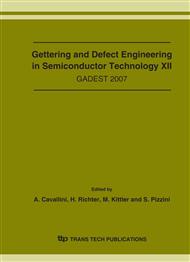[1]
A. Mesli and T. Heiser: Defect and Diffusion Forum Vol. 131-132 (1996), p.89.
Google Scholar
[2]
A. A. Istratov and E. R. Weber: Appl. Physics A Vol. 66 (1998), p.123.
Google Scholar
[3]
A. A. Istratov and E. R. Weber: J. Electrochem. Society Vol. 149 (2002), p. G21.
Google Scholar
[4]
S. Knack: Materials Science in Semiconductor Processing Vol. 7 (2004), p.125.
Google Scholar
[5]
J. Weber, H. Bauch, and R. Sauer: Phys. Review B Vol. 25 (1982), p.7688.
Google Scholar
[6]
M. B. Shabani, T. Yoshimi, and H. Abe: J. Electrochem. Society Vol. 143 (1996), p. (2025).
Google Scholar
[7]
M. Seibt, M. Griess, A. A. Istratov, H. Hedemann, A. Sattler, and W. Schr¨oter: Phys. Stat. Solidi A Vol. 166 (1998), p.171.
DOI: 10.1002/(sici)1521-396x(199803)166:1<171::aid-pssa171>3.0.co;2-2
Google Scholar
[8]
M. Seibt, H. Hedemann, A. A. Istratov, F. Riedel, A. Sattler, and W. Schr¨oter: Phys. Stat. Solidi A Vol. 171 (1999), p.301.
DOI: 10.1002/(sici)1521-396x(199901)171:1<301::aid-pssa301>3.0.co;2-p
Google Scholar
[9]
N. Toyama, Solid-State Electronics Vol. 26 (1982), p.37.
Google Scholar
[10]
A. A. Istratov, H. Hieslmair, C. Flink, T. Heiser, and E. R. Weber: Appl. Phys. Letters Vol. 71 (1997), p.2349.
DOI: 10.1063/1.120026
Google Scholar
[11]
F. Beeler, O. K. Andersen, and M. Scheffler: Phys. Review B Vol. 41 (1990), p.1603.
Google Scholar
[12]
S. K. Estreicher: Phys. Review B Vol 60 (1999), p.5375.
Google Scholar
[13]
C. D. Latham, M. Atalo, R. M. Nieminen, R. Jones, S. ¨Oberg, and P. R. Briddon: Phys. Review B Vol. 72 (2005), p.235205.
Google Scholar
[14]
F. J. H. Ehlers, A. P. Horsfield, and D. R. Bowler: Phys. Review B Vol. 73 (2006), p.165207.
Google Scholar
[15]
S. D. Brotherton, J. R. Ayres, A. Gill, H. W. van Kesteren, and F. J. A. M. Greidanus: J. Appl. Physics Vol. 62 (1987), p.1826.
Google Scholar
[16]
H. Lehmke: Phys. Stat. Solidi A Vol. 95 (1986), p.665.
Google Scholar
[17]
C. B. Collins and R. O. Carlson: Phys. Review Vol. 108 (1957), p.1409.
Google Scholar
[18]
R. N. Hall and J. H. Racette: J. Appl. Physics Vol. 35 (1964), p.379.
Google Scholar
[19]
M. Kittler, C. Ulhaqbouillet, and V. Higgs: J. Appl. Physics Vol. 78 (1995), p.4573.
Google Scholar
[20]
O. F. Vyvenko, M. Kittler, and W. Seifert: J. Appl. Physics Vol. 96 (2004), p.6425.
Google Scholar
[21]
O. F. Vyvenko, M. Kittler, W. Seifert, and M. V. Trushin: Phys. Stat. Solidi C Vol. 2 (2005), p.1852.
Google Scholar
[22]
N. Lehto: Phys. Review B Vol. 55 (1997), p.15601.
Google Scholar
[23]
P. E. Batson: Phys. Rev. Letters Vol. 83 (1999), p.4409.
Google Scholar
[24]
J. P. Hirth and J. Lothe: Theory of Dislocations (Wiley, New York, 1962).
Google Scholar
[25]
R. Jones: J. Phys. (Paris), Colloq. Vol. 40 (1979), p. C6-33.
Google Scholar
[26]
R. Jones, A. Umerski, P. Sitch, M. I. Heggie, and S. ¨Oberg: Phys. Stat. Solidi A Vol. 137 (1993), p.389.
Google Scholar
[27]
S. ¨Oberg, P. K. Sitch, R. Jones, and M. I. Heggie: Phys. Rev. Letters Vol. 51 (1995), p.13138.
Google Scholar
[28]
J. Bennetto, R. W. Nunes, and D. Vanderbilt: Phys. Rev. Letters Vol. 79 (1997), p.245.
Google Scholar
[29]
N. Lehto and S. ¨Oberg: Phys. Review B Vol. 56 (1997), p.12706.
Google Scholar
[30]
A. T. Blumenau, R. Jones, S. ¨Oberg, P. R. Briddon, and T. Frauenheim: Phys. Rev. Letters Vol. 87 (2001), p.187404.
Google Scholar
[31]
A. T. Blumenau, R. Jones, S. ¨Oberg, T. Frauenheim, and P. R. Briddon: J. Phys.: Condens. Matter Vol. 12 (2001), p.10123.
Google Scholar
[32]
P. R. Briddon and R. Jones: Phys. Stat. Solidi (b) Vol. 217 (2000), p.131.
Google Scholar
[33]
J. P. Goss, M. J. Shaw, and P. R. Briddon: Topics in Applied Physics Vol. 104 (2007), p.69.
Google Scholar
[34]
C. Hartwigsen, S. Goedecker, and J. Hutter: Phys. Review B Vol. 58 (1998), p.3614.
Google Scholar
[35]
J. Coutinho, V. J. B. Torres, R. Jones, and P. R. Briddon: Phys. Rev. B Vol. 67 (2003), p.035205.
Google Scholar
[36]
A. Resende, R. Jones, S. ¨Oberg, and P. R. Briddon: Phys. Rev. Letters Vol. 82 (1999), p.2111.
Google Scholar
[37]
N. Yarykin, J. -U. Sachse, J. Weber, and H. Lemke: Mater. Sci. Forum Vol. 258-263 (1997), p.201.
Google Scholar
[38]
N. Yarykin, J. -U. Sachse, J. Weber, and H. Lemke: Phys. Review B Vol. 59 (1999), p.5551 This article was processed using the LATEX macro package with TTP style.
Google Scholar


